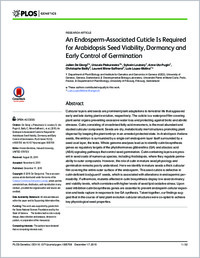An endosperm-associated cuticle is required for Arabidopsis seed viability, dormancy and early control of germination
- Giorgi, Julien De Department of Plant Biology and Institute for Genetics and Genomics in Geneva (iGE3), University of Geneva, Switzerland
- Piskurewicz, Urszula Department of Plant Biology and Institute for Genetics and Genomics in Geneva (iGE3), University of Geneva, Switzerland
- Loubery, Sylvain Department of Plant Biology and Institute for Genetics and Genomics in Geneva (iGE3), University of Geneva, Switzerland
- Utz-Pugin, Anne Department of Plant Biology and Institute for Genetics and Genomics in Geneva (iGE3), University of Geneva, Switzerland
- Bailly, Christophe Developmental Biology Laboratory, Université Pierre et Marie Curie, Paris, France
- Mène-Saffrané, Laurent Department of Plant Biology, University of Fribourg, Switzerland
- Lopez-Molina, Luis Department of Plant Biology and Institute for Genetics and Genomics in Geneva (iGE3), University of Geneva, Switzerland
-
17.12.2015
Published in:
- PLoS Genetics. - 2015, vol. 11, no. 12, p. e1005708
English
Cuticular layers and seeds are prominent plant adaptations to terrestrial life that appeared early and late during plant evolution, respectively. The cuticle is a waterproof film covering plant aerial organs preventing excessive water loss and protecting against biotic and abiotic stresses. Cutin, consisting of crosslinked fatty acid monomers, is the most abundant and studied cuticular component. Seeds are dry, metabolically inert structures promoting plant dispersal by keeping the plant embryo in an arrested protected state. In Arabidopsis thaliana seeds, the embryo is surrounded by a single cell endosperm layer itself surrounded by a seed coat layer, the testa. Whole genome analyses lead us to identify cutin biosynthesis genes as regulatory targets of the phytohormones gibberellins (GA) and abscisic acid (ABA) signaling pathways that control seed germination. Cutin-containing layers are present in seed coats of numerous species, including Arabidopsis, where they regulate permeability to outer compounds. However, the role of cutin in mature seed physiology and germination remains poorly understood. Here we identify in mature seeds a thick cuticular film covering the entire outer surface of the endosperm. This seed cuticle is defective in cutin-deficient bodyguard1 seeds, which is associated with alterations in endospermic permeability. Furthermore, mutants affected in cutin biosynthesis display low seed dormancy and viability levels, which correlates with higher levels of seed lipid oxidative stress. Upon seed imbibition cutin biosynthesis genes are essential to prevent endosperm cellular expansion and testa rupture in response to low GA synthesis. Taken together, our findings suggest that in the course of land plant evolution cuticular structures were co-opted to achieve key physiological seed properties.
- Faculty
- Faculté des sciences et de médecine
- Department
- Département de Biologie
- Language
-
- English
- Classification
- Biological sciences
- License
- License undefined
- Identifiers
-
- RERO DOC 258309
- DOI 10.1371/journal.pgen.1005708
- Persistent URL
- https://folia.unifr.ch/unifr/documents/304634
Statistics
Document views: 60
File downloads:
- men_eac.pdf: 151
